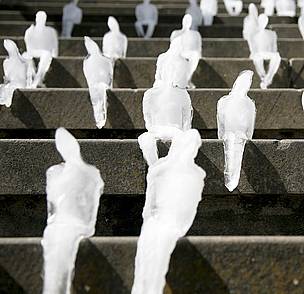Chances are, if you’re already concerned about being off’ed by climate change, it’s probably because you imagine being swept away by a super-charged hurricane, drowned by rising sea levels, starved because of drought-induced crop failure, or set aflame by roaring wildfires. But as it turns out, your risk of perishing by the titans of extreme weather may be a ways off – because the heat may get to you first.
If you didn’t already know, heat is actually the number one killer amongst its weather-related brethren, causing more fatalities than floods, lightning, tornadoes, and hurricanes combined, according to NOAA.
A new report released this week by the NRDC, “Killer Summer Heat: Projected Death Toll from Rising Temperatures in America Due to Climate Change” [PDF], estimates that 150,000 people could die because of heat-related deaths, with numbers increasing over the century as climate change continues to crank up the temperatures. And, predictably so, communities’ ability to cope with the ordeal will depend on our efforts to reduce carbon pollution and employ life-saving adaptive measures.
Cities harbor the majority of the population and are more prone to heat-related problems. The concrete jungles absorb and retain more heat than rural areas (not to mention the concentration of millions of sweaty people in a small area) can also contribute to local temperatures. Furthermore, other factors such as green space and urban structuring (eg row housing vs. high rises) can have an impact as well.
Taking all these factors into account, many cities in the U.S. Midwest and Northeast have higher risks of steam-cooking their populations. Cities in these areas have variable summer climates – it’s not uncommon for a hot streak of consecutive 100-degree days to pop up amidst averages of 80s. To the most vulnerable of the population- including the elderly, obese, and children – these 20-degree rises can prove deadly.
More temperature-stabilized regions, like Miami or Arizona, don’t experience the same risk because people living there are accustomed to sweltering environments and generally have access to protection (such as air-conditioning).
However, cities can vastly reduce the number of deaths if they take preventative measures. The studies show that access to cooling centers, checking in on vulnerable citizens, and increasing the capacity of emergency room and ambulance medical technicians are highly effective.
Even so, the authors of the report call the predictions “conservative.” They didn’t take into account growing population, especially baby boomers, who would likely fall under the “most vulnerable” category.
Additionally, statistics on heat-related deaths in the past may also be conservative because medical examiners generally only label a death as “heat-related” if the body temperature is over 104 degrees. They can’t necessarily label respiratory ailments or heart attacks as heat-related, despite the fact that more people die of those conditions during extreme heat events, leaving the threat of heat understated.
Photo by Rosa Merk – WWF
Subscribe to our newsletter
Stay up to date with DeSmog news and alerts






